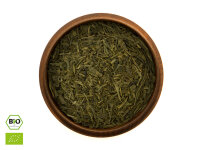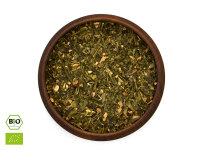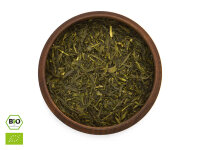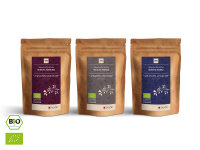
Bancha Tea
Bancha Tea - Green Tea for Everyday
Bancha is the second most popular type of tea in Japan and is considered the tea for everyday consumption. Due to its lower caffeine content, it can be enjoyed multiple times a day. Like all Japanese green teas, Bancha contains valuable nutrients. Bancha has relatively high bioavailable iron content, making it an excellent complement to other green teas such as Gyokuro, Matcha, or Sencha.
Unlike Sencha, Bancha uses larger, somewhat coarser leaves. This is also the origin of its name: a combination of "Ban" (Japanese for coarse/ordinary) and "Cha" (Japanese: tea).
The leaves are gently steamed and rolled using a special technique after being picked. Bancha tea, unlike Sencha, is harvested later. Typically, the first harvest is done at the earliest in June (Nibancha), the second in August/September (Sanbancha), and sometimes there is even a third harvest in October. Roasted Bancha is also a very popular green tea in Japan and is called Hojicha.
Differences in the Quality of Bancha Teas
In general, the earlier the harvest, the higher the quality. As with other green teas, a deep green color is a good sign of quality in Bancha. The highest-quality Bancha (also called Meban) already resemble the fine needles of Sencha in their shape. For this, smaller leaves and buds are plucked lower on the tea plant. Due to the position of the leaves, they are mostly grown in the shade.
The green teas from later harvests can be identified by their significantly larger and coarser leaves and a very mild, less elegant taste. Lower-quality Bancha often contains a high proportion of stems and is often teas without a specific association with a single tea farm. However, we prefer to focus on the higher qualities.
Organic Japanese Bancha Tea at ORYOKI
All our Bancha teas come from selected tea gardens in Japan. We took our time to choose from various Bancha teas from different regions and cultivation areas in the Land of the Rising Sun. The combination of quality, organic farming, and excellent taste was the benchmark for us.
We are currently testing more selected green tea varieties from Japan, some of which will soon complement our green tea assortment.
Preparation of Bancha Tea
Bancha is prepared in Japan in the same way as Sencha tea. For dosing, we recommend about one teaspoon of Bancha per 120 - 150 ml of water. Boiling water should be cooled to around 70°C - 80°C, as otherwise, green tea would immediately lose valuable content and flavor. The steeping time for the first infusion is between 1 and 2 minutes.
Excessive steeping time releases many often unpleasant bitter compounds from the tea, which are not desired. For the second and third infusions, the steeping time should be significantly shorter, around 15 seconds each.
However, even with slight variations in tea preparation, the taste can be influenced in one direction or another. With a little experimentation, the tea can be fine-tuned to your own taste. We recommend making slight variations in water temperature in 5°C increments and adjusting steeping time slightly shorter or longer.





Enjoying Bancha Like in Japan
For tea lovers, especially those for whom green tea plays a significant role, the question of which teapot provides the best tea enjoyment arises relatively soon. For high-quality green teas, the original clay teapot (Kyusu) is traditionally the right choice. The Yokode Kyusu, a side-handled teapot, is the most commonly used type. In our selection, you will find a good variety of handcrafted side-handled teapots by Japanese masters.
Porcelain teapots, a good and beautiful material for this purpose, are also used in Japan. They are often handcrafted using traditional production methods. We also offer porcelain teapots made from Japanese porcelain in our assortment. Our green teapot, So-So, has won design awards and is a very decorative representative of porcelain teapots. Here, the porcelain is of very high quality, thin, and slightly transparent.
The black cast iron teapots, Arare and Hira Arare, stand out due to their style and appearance. Especially important for health: When making a purchase, always ensure that they are originals. Unfortunately, there are often poor-quality imitations available at low prices, and the cast iron of these teapots is usually not beneficial for health!





